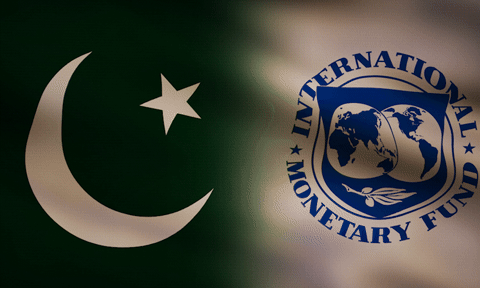Recently, the National Assembly Standing Committee on Finance was informed that Pakistan needs $18.8 billion, excluding a debt rollover. It was also said that Pakistan has to repay a cumulative amount of $100 billion over the next four years.
Currently, Pakistan’s external debt and liabilities are at a modest level. Pakistan’s external debt stock was at 43 percent in June 2023. It declined to 34 percent in June 2024. According to the first quarterly report of the Economic Affairs Division, “64 percent of the total external public debt is concessional with extended maturities.”
Broadly speaking, Pakistan requires an additional $25bn from exports (7 percent annual growth rate in real GDP) to repay our external debt obligations. To meet the challenge, we need to earn an additional $2.08bn every month or borrow the same amount.
Now, where we are lacking from earning perspectives, we import so much more than we export that we run out of foreign exchange reserves. In many economies, this imbalance is made up through remittances or foreign investment. In the case of Pakistan, the former has stagnated and the latter is nonexistent. So, the only solution is to increase remittances and exports with a coherent export-based industrial strategy.
Export-led industrialization is a development strategy that aims to expand trade in goods and develop export surpluses in sectors with a comparative advantage. An orientation towards exports has proven successful worldwide, from Singapore to Rwanda. Before discussing a potential export-driven industrial strategy, it’s helpful to see what policies Pakistan has tried in the past.
The first has been using import tariffs to promote import substitution and industrial growth. This strategy has not produced large-scale industrialization and has failed to increase exports. Another policy was using export rebates and subsidized energy inputs. Despite the limited fiscal space available with the government in the current fiscal year, the textile industry has successfully obtained power subsidies totaling Rs 100 billion, all without the burden of meeting any predetermined growth targets.
Although this support is meant for five export-orientated sectors, the majority of the funds will likely go to the textile players. While the government should work on strengthening the textile industry, which plays a vital role in the economy, it is also necessary to explore other sectors that could boost exports.
Meanwhile, these strategies are now effectively off the table in the face of IMF-mandated expenditure cuts. Another set of more successful policies used tools like reductions in tariffs on intermediate inputs for exporters, subsidized credit for exporters, and tax refunds for exporters who prove that they have used imported inputs for export purposes.
On the other hand, commitment to export-led growth and subsequent liberalization of trade barriers generates an increase in foreign direct investment and other forms of investment. Liberalization removes barriers such as tariffs and controls that hinder capital flows.
When these barriers are eliminated, countries become more attractive for investments, as investors are encouraged by the ease of doing business and the potential for market access. Furthermore, supply chain integration plays a significant role in motivating technology transfers and investment.
As countries integrate into the global supply chains, they gain access to advanced technologies and expertise from their trading partners. Additionally, trade has enabled more women to transition from informal and domestic labor into the formal sector, providing better working conditions and greater economic empowerment.
For example, the government introduced the Regionally Competitive Energy Tariff (RCET) in 2018 and quickly reneged on it merely four years later. The textile sector’s investments in increased capacity, expansion, and over $5 billion in research and development were suddenly rendered moot.
The four years of export growth could not be translated into development due to inconsistent implementation of policy. Similarly, Pakistan has thrice attempted to reform its railways since 2018 and failed to follow through on any of its proposed acts. The issue of half-hearted implementation reduces investor confidence and prevents exports from being able to earn their growth potential.
Additionally, there is also a need to diversify the sources of remittances, more so in the fast-changing geopolitics of the Gulf Cooperation Council region and Pakistan’s slow yet visible political distancing with the US and the UK. Even if our relations with Saudi Arabia and the UAE remain strong, will these two countries remain conducive for Pakistani workers amidst growing competition with the diaspora of other nations? There is also a possibility that the UK and US-based Pakistanis may send fewer remittances to Pakistan if political instability in the country grows. Pakistan needs to aim for deeper penetration into the future remittances market now. The skilled and highly skilled workforce may have better job prospects in countries like Japan, South Africa, South Korea, and Malaysia. Conclusively, no matter your opinions on industrial policy, no one can realistically deny that the current export strategy is not working.
Economic and political instability drives away foreign investment and scares domestic producers from increasing their capacity and moving into higher value-added products. But if stability does return, policymakers must be ready to take advantage of this by pushing an export-driven industrial strategy in a big way. Without increasing export earnings, our stability will continue to depend heavily on foreign debt, loan rollovers, and commercial domestic debt instruments.
However, stability that is reliant on debt financing is always transitory and increases speculation and uncertainty about the future. In a nutshell, the economy means growth for businesses and opportunities, which we have to earn instead of resorting to borrowing.
Copyright Business Recorder, 2024
The writer is an economic analyst.
Email: msherozkhanlodhi@accountant.com

























Comments
Comments are closed.